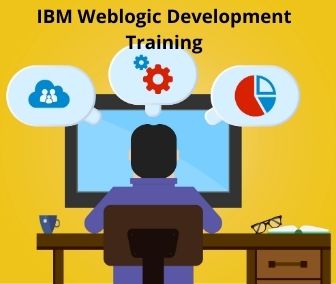
Introduction to IBM Weblogic Development Training:
IBM Weblogic Development is provided by ‘IdesTraining’ which is one of the best Corporate training providers in India. Idestrainings take our unrivaled classroom experience straight to your computer with real time classes. IBM Weblogic Development Corporate Training available anywhere you are from home or office. IdesTrainings providing the best Weblogic Developer training at a reasonable price. Before going to the details of IBM Weblogic Development training, let’s have a look at the basics of IBM Weblogic Development. Let’s see what exactly IBM Weblogic Development is, IBM Weblogic Development is the application server across conventional and cloud environments.
Prerequisites for IBM Weblogic Development training:
- Basic operational skills for the Linux operating system
- Administrative skills for a web server, such as IBM HTTP Server or Apache
- Basic understanding of cloud concepts, private, public, and hybrid clouds, and traditional on-premises environments
IBM Weblogic Development Corporate Training Course Outline:
- Course Name: IBM Weblogic Development Training
- Duration of the Course: 40 Hours (It can also be optimized as per required period).
- Mode of Training: Classroom and Corporate Training
- Timings: According to one’s Feasibility
- Materials: Yes, We are providing Materials for IBM Weblogic Development Corporate Training (We will get the soft copy material)
- Sessions will be conducted through WEBEX, GOTOMETTING or SKYPE
- Basic Requirements: Good Internet Speed, Headset.
- Trainer Experience: 10+Years
- Course Fee: Please register in our website, so that one of our agents will assist you.
Overview of IBM Weblogic Development Corporate Training:
WebLogic Server implements Java Platform, Enterprise Edition (Java EE) Version 5.0 technologies. Java EE is the standard platform for developing multi-tier Enterprise applications based on the Java programming language. The technologies that make up Java EE were developed collaboratively by Sun Microsystems and other software vendors, including BEA Systems.
An important aspect of the Java EE programming model is the introduction of metadata annotations. Annotations simplify the application development process by allowing a developer to specify within the Java class itself how the application component behaves in the container, requests for dependency injection, and so on. Annotations are an alternative to deployment descriptors that were required by older versions of Enterprise applications (J2EE 1.4 and earlier).
According to Sun, “the focus in Java EE 5 is ease of development. With Java EE 5, there is less code to write – much of the boilerplate code has been removed, defaults are used whenever possible, and annotations are used extensively to reduce the need for deployment descriptors.”
EJB 3.0 makes it much easier to program an EJB, in particular by reducing the number of required programming artifacts and introducing a set of EJB-specific metadata annotations that make programming the bean file easier and more intuitive. Another goal of EJB 3.0 is to standardize the persistence framework and reduce the complexity of the entity bean programming model and object-relational (O/R) mapping model. WebLogic Server continues to support Version 2.1 of the EJB specification.
- Java EE 5 includes simplified Web Services support and the latest web services APIs, making it an ideal implementation platform for Service-Oriented Architectures (SOA).
- Constructing web applications is made easier with JavaServer Faces (JSF) technology and the JSP Standard Tag Library (JSTL). Java EE 5 supports rich thin-client technologies such as AJAX, for building applications for Web 2.0.
WebLogic Server Java EE applications are based on standardized, modular components. WebLogic Server provides a complete set of services for those modules and handles many details of application behavior automatically, without requiring programming.Java EE defines module behaviors and packaging in a generic, portable way, postponing run-time configuration until the module is actually deployed on an application server.
Java EE includes deployment specifications for Web applications, EJB modules, Web Services, Enterprise applications, client applications, and connectors. Java EE does not specify how an application is deployed on the target server—only how a standard module or application is packaged. For each module type, the specifications define the files required and their location in the directory structure.
Conclusion to IBM Weblogic Development Training:
Idestrainings team provides a successful combination of large customer service knowledge and depth product experience information to help you deliver differentiated customer knowledge. From a planned performance to always-on service, we build sure you get the most excellent worth out of IBM Weblogic Development. IdesTrainings is the best for IBM Weblogic Development Corporate training. We are the best Corporate training providers; we just don’t teach you the technologies rather we make you understand with live examples, the sessions we conduct are interactive and informative. If the candidates miss any of the sessions due to some unavailability, we will give assurance for backup sessions. IdesTrainings Team will be in switch on mode for 24/7 and will solve any issues regarding the training, timings, trainer or server. We are ready to solve any issues within no time. We are providing the best IBM Weblogic Development Online training at a reasonable price. We also provide IBM Weblogic Development Classroom Training in India at Hyderabad, Bangalore, Noida, Pune, Chennai etc., We have core team of experts for this IBM Weblogic Development training. As it is an online training, the training timings will be the candidate feasibility. For details of this IBM Weblogic Development training course, you can contact with the Idestrainings team.

